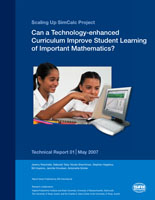About SRI International
Silicon Valley-based SRI International is one of the world's leading independent research and technology development organizations. Founded as Stanford Research Institute in 1946, SRI has been meeting the strategic needs of clients for more than 60 years. The nonprofit research institute performs client-sponsored research and development for government agencies, commercial businesses and private foundations. In addition to conducting contract R&D, SRI licenses its technologies, forms strategic partnerships and creates spin-off companies.
SRI's Center for Technology in Learning aims to improve learning and teaching through innovation and inquiry. The Center's research and development activities contribute to the knowledge base on effective learning and teaching, and embody research insights in the innovative design, use, and assessment of interactive learning environments. Much of the Center's work is conducted in educational settings such as classrooms, after-school programs, and teacher education programs.
SRI International Study Shows Increased Middle School Mathematics Learning with Technology-Based Approach
First-of-a-kind scientific study demonstrates the effectiveness of a new approach to math educationMENLO PARK, Calif. – May 21, 2007 – Scientists from SRI International, an independent nonprofit research and development organization, today released the results of its evaluation of a new approach to learning conceptually difficult middle school mathematics. SRI has provided compelling evidence that SimCalc, a technology-enhanced mathematics program, has increased students' mathematics learning.
Scientific Evaluation Offers Compelling Results
SRI's Center for Technology in Learning completed its first large-scale study of the SimCalc program during the 2005-2006 school year as part of a four-year National Science Foundation (NSF) grant. The study found that SimCalc materials, designed to teach higher level mathematics through an approach that integrates technology, curriculum and professional development, resulted in significant learning gains for a broad cross section of students throughout the state of Texas. A diverse group of approximately 1600 students and 95 teachers from 74 schools participated in this experiment, in which scientists randomly assigned schools to use either SimCalc materials or their usual textbooks to teach rate and proportionality.
Although random assignment experiments are rare in education, such experiments provide the strongest evidence of the effectiveness of innovative approaches. In this experiment, researchers found that students using Texas' typical curricula increased their test scores by an average of 19%, while students using the innovative SimCalc materials gained an average of 46%. Statistically, the size of the SimCalc effect was measured at 0.84, which is considered a large effect in education. In comparison, a recent U.S. Department of Education evaluation of 15 alternative technology-based products found no effects.
Researchers have long observed that the effectiveness of educational technology depends on the nature of the software used, the degree of integration of technology with the core curriculum and instruction, and the sensitivity of the test to student learning. SimCalc's large effect – strong enough to move the average student from the 50th percentile to the 80th percentile on a test of relevant mathematics – provides scientific evidence for the distinctive contribution of SimCalc's integrated approach to improving student learning.
Gains on the rate and proportionality test were particularly pronounced in more advanced, conceptually difficult mathematics. For example, students learned to use graphs, tables and formulas to represent real-world phenomena such as motion. In addition, they extended their study of proportion to algebraic functions. These topics are recommended for middle school in the Curriculum Focal Points recently established by the National Council of Teachers of Mathematics, though they are often left out of widely used middle school textbooks.
"Both mathematicians and scientists see the concepts of rate and proportionality, a focus of middle school, as essential for learning in high school and beyond. On these crucial concepts, we found strong learning gains across varied regional demographics and school conditions; a range of teacher backgrounds, attitudes and philosophies; and differences in students' ethnicity, poverty level and gender," said Jeremy Roschelle, Ph.D., director of SRI's Center for Technology in Learning and principal investigator of this study. "These robust results show the power of an integration of software, curriculum, and teacher training to enable all students to make progress in important yet conceptually difficult mathematics."
The study tested a 2-3 week technology-enhanced unit on rate and proportionality, a central part of middle school mathematics that builds important foundations for students to learn more complex mathematics such as algebra and calculus. After completing a training workshop over the summer, teachers were randomly assigned either to teach with their usual Texas curriculum or to replace their usual materials with the SimCalc software and curriculum. To measure learning, researchers gave students a test of rate and proportionality concepts both before and after they were taught the unit.
Later this year, SRI plans to release second-year results from the 7th grade study along with results from a parallel 8th grade study. The additional data will add to researchers' understanding of the results announced today. Additional research in Massachusetts is exploring the impact of SimCalc and classroom networks in high school mathematics learning. SRI and the University of Massachusetts are also collaborating to support studies of SimCalc in Singapore schools, a first step toward international impact.
James J. Kaput, Ph.D., of the University of Massachusetts, Dartmouth designed the SimCalc program in the early 1990s to achieve his vision of "e;democratizing access to the mathematics of change,"e; i.e., making concepts of proportionality, linearity and rates of change accessible to students of all cultural and demographic backgrounds. Through use of interactive software, the SimCalc program advances student learning of proportionality beyond the familiar cross-multiplication procedure. The SimCalc MathWorlds™ software runs on computer, handheld, and graphing calculator hardware, and versions are complimentary at a University of Massachusetts, Dartmouth website.
The development of SimCalc and this experiment have been supported by grants from the NSF. Research collaborators include Virginia Tech; University of Massachusetts, Dartmouth; the University of Texas, Austin; and the Charles A. Dana Center at the University of Texas, Austin.



